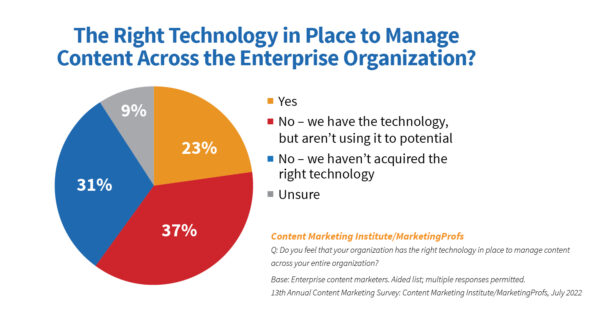Navigating work in a large organization comes with unique challenges, especially in times of change.
But one thing remains constant – communication endures as one of the thorniest issues.
So it’s no surprise in our newly released Enterprise Content Marketing: Benchmarks, Budgets, and Trends – Insights for 2023, well over half (64%) of enterprise content markers say communicating among internal teams/silos is a challenge.
That’s one of the findings from the analysis of the 278 enterprise marketers (those working in companies with at least 1,000 employees) who completed our annual content marketing survey.
64% of enterprise #content marketers say communicating among teams/silos is a challenge, according to @CMIContent #research via @EditorStahl. Click To TweetHere’s a snapshot of the content marketing practices, challenges, opportunities, and 2023 plans they shared with us.
Common challenges of enterprise content marketers
Close in popularity to the internal communication challenge is creating content that appeals to different stages of the journey (62%). Among the other most frequently cited challenges of enterprise marketers: technology integration (41%), accessing subject matter experts to create content (38%), achieving consistency with messaging (37%), developing consistency with measurement (37%), and differentiating products and services from the competition’s (37%). Interestingly, only 24% say continuing to make a business case for content marketing is a challenge (and 1% say they have no challenges.)

In their open-ended (qualitative) responses, many enterprise content marketers told us they want to see content marketing centralized within their organization. Even more expressed a desire to see silos torn down.
Lynn Heidmann, senior director of content marketing at Dataiku, found a solution at her enterprise. Though the central content marketing team owns content creation for global marketing campaigns, it isn’t the only team producing external-facing content. Other teams create all content for partners, customers, and prospects.
To maintain a consistent content approach and keep everyone up to date, the central content marketing team shares “lots of best practices [things like central messaging documentation, style guides, etc.] and offer(s) up our time for reviewing other teams’ work, involving them in our workflows where we can try and streamline as much as possible.”
Technology is an issue
Tools and technology can be an especially fraught issue in enterprises. Buying decisions sometimes takes ages, and solutions that work well for one team might not suit another.
In a new question on the annual survey, we asked marketers if they thought their organization had the right technology to manage content across the organization. Only 23% say yes. Nearly a third (31%) say no. Even more (37%) say they have the technology but aren’t using it to its potential.

Having and using the right technology sets top-performing content marketers apart. Of those who think their organization is extremely or very successful with content marketing, 38% say they have the right technology to manage content across the organization compared to 23% of all enterprise marketers.
Enterprise marketers who report being extremely or very successful are more likely than all marketers to have the right tech to manage #content across the organization, according to @CMIContent #research via @EditorStahl. Click To TweetThat makes sense to CMI’s chief strategy advisor Robert Rose who recently said, “Any marketing technology worth purchasing involves implementation, training, user learning curve time, and ongoing administration.”
Is tech a solution to all your content woe? No. Does that mean it’s not worth addressing? Of course not. The first step, Robert advises, is to get your processes in order before shopping for the tech to help them.
“I’ve been advising clients and colleagues to worry less about which new technology will be a must-have for 2023,” he writes. “Instead, work on developing the muscle to evolve content activities into repeatable processes.”
(Read more of Robert’s advice in this Rose-Colored Glasses column, Your 2023 Planning Shouldn’t Be All About That Tech.)
More differentiators of top performers
Top-performing enterprise marketers also stand apart from their peers by always/frequently making their content different. They craft content based on stages of the buyer’s journey (72% vs. 47%) and prioritize the audience’s informational needs over their organization’s (81% vs. 61%).
Eighty percent of the top performers say they always/frequently differentiate their content from the competition compared to 53% of all enterprise marketers who say the same.

How do they do it? Well, the same ways are most popular among the top performers and all marketers: producing better quality content (86% of top performers, 85% of all marketers) and covering topics/stories that their competitors don’t (71% for top performers and all marketers).
But the top performers are more likely to do these things than all marketers:
- Produce more content (41% of top performers vs. 31% of all marketers)
- Do a better job distributing content (38% vs. 29%)
- Promote actively the content they publish (58% vs. 53%)
Jeff Revilla, digital marketing director for Smail Auto Group, manages all content operations for 10 franchises. He says his organization differentiates its content by taking the customers on journeys about what they’re most interested in – the vehicles’ features.
“Most of the content in automotive centers around the dealer screaming, ‘We have inventory’ or ‘Look at these deals!’ We took a different approach. Instead of talking about us, we created a series of videos that take the customer through a journey of the vehicle. We only mention our name in the intro, never talk about price, and only focus on the features that a car owner would care about. Once we figured out that formula, our YouTube growth was exponential.” Since 2008, Smail Auto Group’s YouTube channel has had almost 2.5 million views.
In-person events are back
This trend doesn’t surprise me at all – in-person events are back. We’ve seen it and participated in it.
Sixty-three percent of enterprise marketers report using in-person events this year – that’s 2.5 times more than the previous year’s survey.
Use of in-person events by enterprise marketers jumped 2.5 times this year over last year, according to @CMIContent #research via @EditorStahl. Click To TweetIn addition, 56% expect their organization’s in-person event investment to increase in 2023 compared with their 2022 budget.

Having the right content to support these in-person events can extend the audience’s experience and the enterprise’s investment.
Dataiku’s Lynn Heidmann shares that her team has a hand in shaping the narrative of the brand’s event content. “A memorable, well-crafted message on stage is what people come to events for, so that’s what works best, and we try to support that,” she says.
And make sure to capitalize on the events for future content. “We’ve had great success with on-site surveys, which are a great way to collect data that you can reuse in later content pieces,” Lynn says.
Video investment continues to rise
Another finding everyone (enterprise or not, content marketer or consumer) already sees? The use of video.
Among enterprise content marketers, the use of video increased to 87% from 79% the previous year, making it the second most often used type of content. Now it’s second only to short articles/posts (89%).

Among the other content assets used in the last 12 months:
- Virtual events/webinars/online courses (77%)
- Long articles/posts – more than 1,500 words (71%)
- Case studies (68%)
- Infographics/charts/dataviz/3D models (68%)
- E-books/white papers (64%)
- In-person events (63%)
- Podcasts and other audio content (44%)
- Research reports (42%)
- Livestreaming content (27%)
- Print magazines or books (23%)
Video also tops the list of predicted content marketing investments in 2023, with 83% expecting to spend money on video for their enterprises.
Among the other popular categories for investment:
- Owned-media assets (67%)
- Paid media (67%)
- Events – digital, in-person, hybrid (63%)
- Earned media (53%)
- Social media/community building (53%)
- Getting to know audiences better (38%)
- User experience design (36%)
- Audio content (25%)
- Content technologies (20%)

Video’s place at the top of the investment list is good news because it’s one of the top five content assets that produced the best results for enterprise marketers in the last 12 months.
Will 2023 be a bumpy ride?
Your team may grow or shrink. Your budget may rise or fall. Your content may succeed or struggle. To manage those surprising and expected events, use these and the rest of the findings to get your bearings for the rest of 2023.
Amy Fair, content marketing manager at SpyCloud, sums up the 2023 vibe for enterprise and other marketers beautifully: “I would encourage folks to continue to nurture their networks to ensure they have a robust support system at all times … You never know when you could be impacted, and making sure you have built solid relationships with colleagues who are there for you can be a lifesaver, both literally and figuratively.”
HANDPICKED RELATED CONTENT:
Cover image by Joseph Kalinowski/Content Marketing Institute

